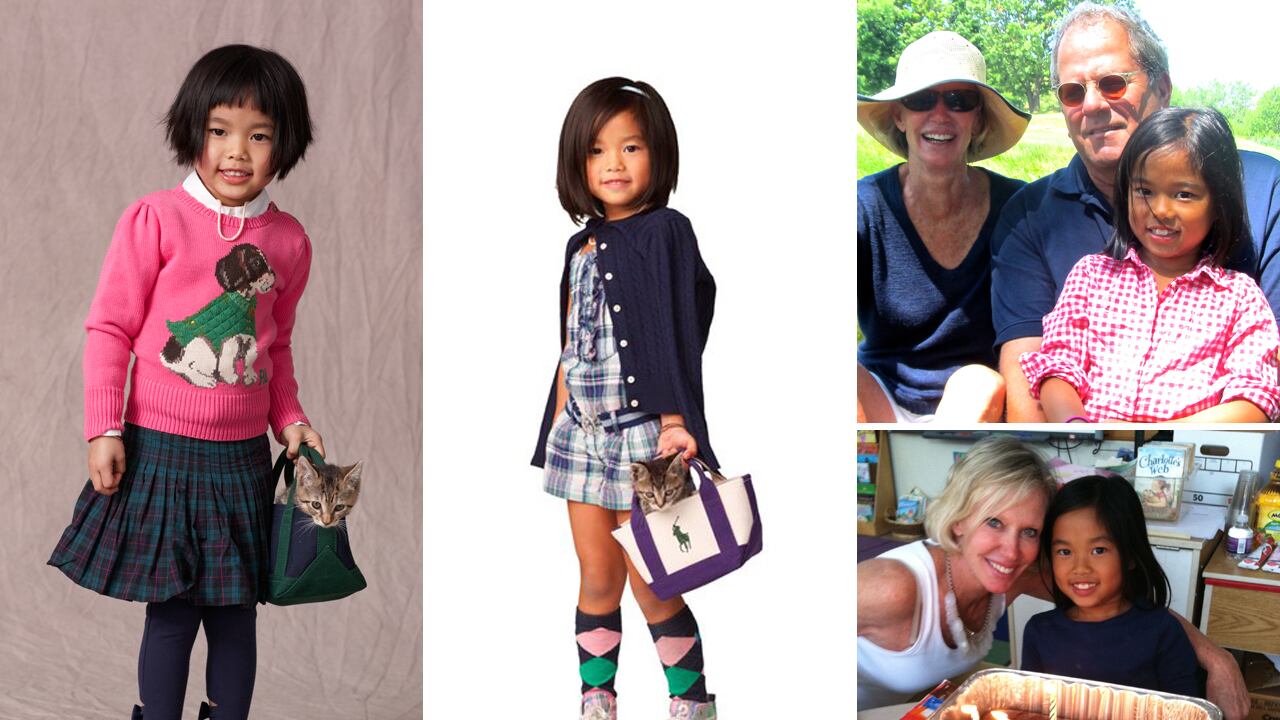
Ralph Lauren’s corporate headquarters at 650 Madison Avenue in Midtown Manhattan has temporarily transformed into a small-scale version of the Fashion Week tents at Lincoln Center. Preteen girls in cable-knit sweaters clutch their mothers’ hands tightly as they smile for photographers in the wood-paneled lobby. A gilded chandelier casts a dim light over an open space in the middle of the room, which has been cleared to form a runway. On the far wall, spotlights shine on a large white backdrop inscribed with “RALPH LAUREN” in bold letters. It’s September 5, 2012, school has just let out for the day, and it’s hours until the official launch of Mercedes-Benz Fashion Week. This crowd has gathered to see the designer’s second-ever fall and holiday children's wear runway show, featuring members of the RL Gang, the eight child models for Ralph Lauren’s two-year-old ad campaign. The group has gained recognition among the Nickelodeon set through a popular storybook series—available in print and online—that gives each model a character name and backstory. Charlotte Caizhu Berger, who goes by the nickname Zhu Zhu, plays the role of Mae, and is the only Asian in the preppy-clad coterie.
At 4 p.m. on the dot, the lights dim, the music—upbeat, bubbly electropop—begins piping through the speakers, and the first model takes her walk. Minutes later, Zhu Zhu appears, smiling nervously. She has naturally bronze skin and a black bob. Her face is round, and her dimpled smile is accented by two front teeth that resemble Chiclets. She’s eight years old—the oldest in the RL Gang—but her four-foot-tall frame is tiny and compact (Ralph Lauren representatives call it “travel size”), which is why she’s grouped in with the younger children. Her outfit looks straight out of a Christmas catalog: a scarlet wool peacoat is layered over black tights and paired with gray embroidered ballet flats. The look is topped off with a floral headband and a set of mittens, to perpetuate the holiday theme.

Although Zhu Zhu is playing a part in Ralph Lauren’s winter wonderland fantasy, eight years ago, she was far removed from its reaches: she was abandoned in a basket on the side of a road in southern China. Her story is one of lucky breaks and second chances—it highlights a fortuitously avoided upbringing in the Chinese social welfare system and the effects of being taken in by a well-to-do family.
On June 27, 2004—one day after Zhu Zhu was born—an anonymous phone call rang in the Qinzhou police office. A female baby was on Ximeiyuan Road, a high-traffic area in the western part of the city, located in the Guangxi autonomous region of southern China. An officer went to retrieve the infant, but when he arrived to pick her up, the person who called was nowhere in sight. At that moment, Zhu Zhu became the property of the Chinese government, along with 10,000 other children abandoned each year in China. As is custom, a picture of Zhu Zhu ran in the local newspaper, Guangxi Daily, along with the details of her discovery. Because the Chinese are accustomed to abandonment, due to the country’s large population, its one-child restriction laws, and the belief that young girls are less suited to work and support the family, Zhu Zhu's birth parents were never found.
Zhu Zhu was then taken into foster care at the Qinzhou Social Welfare Institute (SWI), a large and desolate-looking concrete building on Yong Fun Road with green-tinted windows. The place feels caged in and secluded, so much so that, when an American couple from suburban New York dropped by on their trip to pick up Zhu Zhu when she was 19 months old, the other orphans were hanging out of the windows waiting to greet them.
“Sadly, those kids aren’t used to families,” explained Zhu Zhu’s adoptive mother, Janet Lyons, a slim, blonde, blue-eyed woman with a raucous voice. Her husband, Dennis Berger, a stout 67-year-old man with curly gray hair and a friendly demeanor, chimed in: “They have got to fight for everything they get, and the weak ones get just really lost.”
On September 25, 2004, Zhu Zhu experienced her first of many strokes of luck. She was chosen at random and transferred from the SWI to an experimental foster program called Mother’s Love, located in Nanning, a city approximately four miles east of Guangxi. Compared to the Social Welfare Institute, Mother’s Love was a palace, equipped with tile floors, wooden cribs, and a large open courtyard. But the clock was ticking for Zhu Zhu: if she didn’t get adopted before she turned 4, she would be sent back to the SWI, where it would be increasingly difficult to find her a family the older she got. She was officially adopted by Lyons and Berger on February 8, 2006.

We're seated in the living room of the Berger's big gray house in Bronxville, N.Y., an affluent and predominantly white suburb 15 miles north of midtown Manhattan. The property boasts four bedrooms, five bathrooms, and a swimming pool in the backyard. It’s a lot for just three people—Lyons and Berger’s other two children, Lucas, their only biological child, and Jack, Lyons’s son from a previous marriage, have already moved out of the house. (Before Lyons and Berger met, in 1989 as colleagues at New York–based advertising agency BBDO, they’d each been married once before.) Because Zhu Zhu, Lucas, and Jack all have different biological fathers—and different surnames by birth—there’s a very nonchalant attitude in the family regarding her adoption. Zhu Zhu is hyperaware of the fact that Lyons and Berger are not her birth parents, and that she used to live in China.
“The advantage to being racially different than your parents is it is very clear that you are adopted,” Lyons said. “You are from another world, and you hear it every day—it becomes so ingrained as a part of who you are.”
Zhu Zhu is pacing in and out of the room as her parents candidly explain her adoption story. Within an hour of meeting a visitor for the first time, she’s showing off old photos of herself as a newborn baby in China, in a small album compiled by her adoptive parents—one of her most prized possessions. Her knack for modeling is evident in the pictures: in one, she dons traditional Chinese garb and smiles naturally for the camera.
Zhu Zhu’s modeling career began in 2009, when Lyons found herself between jobs. Berger called up an old friend, a casting agent at BBDO—where he and Lyons formerly served as executive creative directors—who recommended the talent agency CESD. They signed Zhu Zhu on the spot.
Her first audition was a massive casting call for Ralph Lauren—to fill an ad campaign for the new childrenswear line that season. At the casting, Ralph Lauren representatives were searching for the children who best exemplified “the Ralph Lauren look”: preppy, happy, fresh-faced, attractive. A special rating system helped weed out the candidates quickly, and Zhu Zhu made it to the final round. A few days later, Lyons received the phone call: Ralph Lauren loved Zhu Zhu and wanted her to star in the RL Gang. At the ripe old age of 5, she was officially a working model.
Spearheaded by David Lauren, Ralph Lauren’s second son and senior vice president of advertising, marketing, and corporate communications for the company, the RL Gang is an online storybook that highlights eight characters’ personalities and individual styles. If readers like a particular outfit, they can click through to purchase it via Ralph Lauren’s online store. The impetus behind the project was to create a more interactive marketing strategy that engages children in the buying process. Zhu Zhu was cast as “the preppy one.” In one of the RL Gang’s most recent videos, a cheery Zhu Zhu, dressed in a blue ruffled jumper and seersucker blazer, rides a school bus with her classmate. A small canvas handbag, emblazoned with Ralph Lauren’s signature pony logo, rests on the seat next to her, with a small kitten inside. This portrait of a beautiful, lighthearted child was key to representing the idyllic Ralph Lauren lifestyle.
“They are making something seem like something that you want,” said Liz Scott, a former producer at Ralph Lauren. “A little girl wearing preppy clothes with a kitten—people want to be like her and wear those same clothes.”
On a brisk November morning, Zhu Zhu is sitting in her third-grade classroom at Bronxville Elementary School, a large brick building attached to the high school, which ranks second among public schools nationwide with open enrollment, according to a 2013 study in Newsweek. At lunchtime, she sits at a table with four boys and enjoys an uncharacteristic (for a model) meal of pizza and cookies. Her favorite food, she says, is tacos, and her favorite Chinese dish is a tie between sesame chicken and beef. After school, she heads to an enrichment program: architecture on Mondays, rocketry on Tuesdays, and sculpture on Wednesdays. If her jam-packed schedule is proof of anything, it’s that Zhu Zhu is a curious child—and a quick learner. Within a month and a half of living in America, she had already learned English.
“She’s definitely a very bright girl,” said Kaysh Shinn, Ralph Lauren’s “child wrangler”—a term used within the company to describe the person responsible for handling children on photo shoots. Shinn works with child models onset to get them to relax and ensures that there is a safe environment. “[The vice president of advertising and design at Ralph Lauren] kept asking her, ‘So are you going to Harvard? Are you going to Yale?’"
Part of what attracts the Bergers to Ralph Lauren is the kind staff and the high quality work that they do. There’s also the familiarity of a family-run company: most of the people who work at Ralph Lauren remain there for years.
“It feels like a family when you’re on those shoots,” Scott said.
Six months later, sitting on the couch in her basement playing Nintendo Wii Golf, Zhu Zhu’s mind seems to be wandering. Ralph Lauren had unveiled its fall ad campaign for the RL Gang, and another Asian girl—with fairer skin and longer hair—was cast as Mae.
“They replaced me on the RL Gang,” she said matter-of-factly. “I’m OK with it because my mom said that I look older.” She paused briefly and resumed her game.
Zhu Zhu didn’t seem to be bothered by the news. That’s the beauty of youthful resilience: things don’t make as much of an impression as they do later in life. Compared to Zhu Zhu’s early memories, the loss of a modeling gig is trivial. A spokesperson for Ralph Lauren said that Zhu Zhu simply “grew up” and they had to find somebody younger-looking for the character of Mae.
“[Ralph Lauren] is always looking for new faces, especially in childrenswear, because people grow up so quickly so they’re always looking for new models to be part of the campaigns,” the spokesperson said. “Often it’s just a matter of scheduling—parents can’t bring them in and [we] have to find someone else.”
When asked whether she’d be comfortable with Zhu Zhu modeling in the future, Lyons said she wouldn’t be opposed. “If somehow it naturally came up again and it was something she wanted to do, I would be more than happy with it,” she said. But something Zhu Zhu might not enjoy, she said, is modeling in the “girls” age group, which spans roughly from age 7 to age 11. “[Modeling for the “girls” age group] might not be as much fun—it might be a little intimidating,” she said. “Though she doesn’t get intimidated too easily.”
This story is an excerpt from Claire Stern’s master’s project at the Columbia University Graduate School of Journalism.
Correction: An earlier draft of this article stated that Guangxi is a province, when in fact it is an autonomous region.






